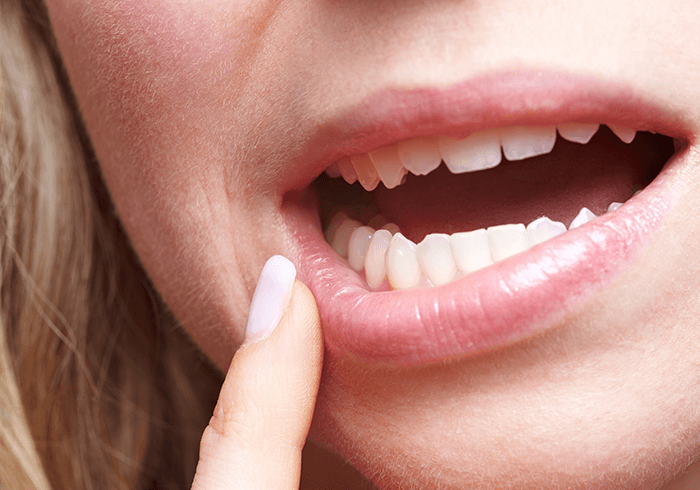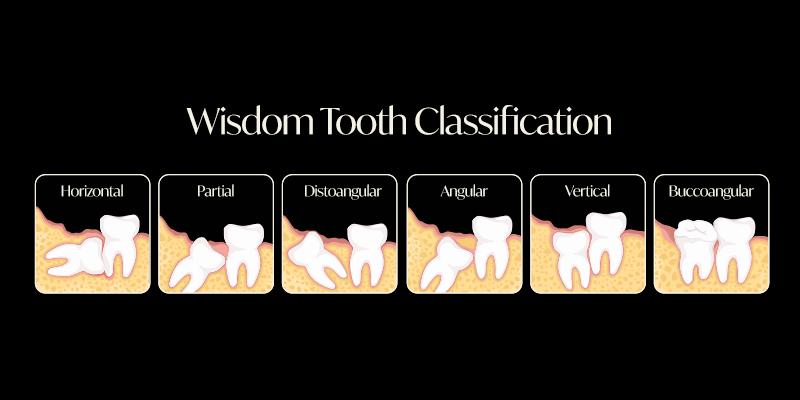Book an appointment
or ask a question
Leave your details here and a member of our team will be in touch momentarily.
Wisdom teeth, also known as third molars, are the last set of molars to emerge in the back corners of the mouth. They usually appear between the ages of 17 and 25, although the timing can vary widely among individuals. These teeth were historically believed to emerge at an age when a person gains wisdom, hence the name “wisdom teeth.”
However, in modern times, wisdom teeth often pose problems due to their late eruption and limited space in the mouth. Many people experience issues such as impaction, where the teeth don’t have enough room to emerge properly, leading to pain, infection, and potential damage to nearby teeth and bone. Consequently, wisdom teeth are commonly extracted to prevent such complications.
Not everyone will develop wisdom teeth, and in some cases, they may erupt without causing any problems. However, monitoring their development through regular dental check-ups is crucial to addressing any potential issues promptly.
While wisdom teeth removal can cause discomfort during and after the procedure, many people do not experience significant pain and can resume normal activities within a few days. In fact, removing wisdom teeth can prevent future dental problems such as gum disease, tooth decay, and overcrowding, which can lead to more pain and discomfort in the long run. Additionally, modern techniques for anesthesia and pain management have greatly improved the patient experience during wisdom teeth removal, making the procedure less painful than in the past. With proper postoperative care, most people can recover quickly and without significant pain.
Most people’s wisdom teeth, which are also called third molars, emerge between the ages of 17 and 25, although the specific timing can differ among individuals. Some people can experience the eruption of their wisdom teeth sooner or later than this age range, while others may not develop them at all.
The majority of people will form 4 wisdom teeth – one in each quadrant of the mouth. Some, however, will only develop 1, 2 or 3. Some will also develop extra teeth and have 5, 6, 7 or 8 wisdom teeth or even more in some cases. Over time, the wisdom tooth has become an evolutionary remnant, not required and often unable to erupt due to a lack of space.
Every patient is unique and no one or two people will have the exact same situation. For further information and assessment of your particular case, please contact Dr Jaclyn Wong’s rooms to arrange a consultation.
Yes, wisdom teeth can sometimes cause sinus problems. This is particularly true if the upper wisdom teeth are impacted or infected, as their roots can extend close to or into the sinus cavities. When the roots of these teeth cause pressure or infection, it can lead to sinus congestion, pain, or even sinus infections. If you experience frequent sinus issues and have wisdom teeth, it’s worth consulting with Dr Jaclyn Wong to explore any potential connection and determine if removal might help alleviate your symptoms.
Not necessarily. While impacted wisdom teeth often require removal due to potential complications such as pain, infection, or damage to surrounding teeth, not all impacted wisdom teeth need to be extracted. The decision depends on various factors, including the degree of impaction, the angle of the tooth, and the individual’s oral health. In some cases, impacted wisdom teeth may remain asymptomatic and pose no immediate threat, allowing for monitoring rather than immediate extraction. However, it’s essential to consult with a dentist or oral surgeon to evaluate the specific circumstances and determine the best course of action for your oral health.
The best time to have wisdom teeth removed is as soon as they start to cause problems, such as pain or jaw issues.
In cases where wisdom teeth are causing severe dental problems, a dentist might recommend removing them even if the person is younger than 20 years old because it reduces the potential for future complications that could require more extensive oral surgery.
It is also worth considering the “preventative” removal of wisdom teeth, at a time when the patient is young and before the teeth fully develop roots. The advantages of this are that the bone around the wisdom teeth is softer and the tooth easier to remove. If the roots haven’t fully formed, they are less likely to be near the feeling nerve to the lip and as a result less likely to injure the nerve. Recovery also tends to be faster in younger patients.
If the tooth is removed before it impacts and causes pain, food accumulation or decay, there will also be less chance of needing to take time off work or school due to infection, pain or swelling and there is less risk that the teeth adjacent to the wisdom teeth become decayed or damaged. Often when a patient is younger, they are also fitter and healthier and less likely to have medical problems that may complicate the procedure.
Often wisdom teeth are indicated for removal before or after orthodontic treatment (braces or Invisalign) to allow space in which teeth can move to allow them to be straightened or aligned.
We may also consider removing the wisdom teeth if the patient needs to have surgery to remove other complicated teeth for orthodontic treatment. Removing the wisdom teeth at the same time will prevent the need for another surgery later on in life, especially if there is already crowding as wisdom teeth are unlikely to erupt properly and be cleansable in an already crowded mouth.
The removal of wisdom teeth can bring several advantages, including preserving proper teeth alignment, reducing the chance of gum disease and tooth decay, preventing impaction and infection, and eliminating any associated pain and discomfort.
Recovery time after wisdom teeth removal can vary depending on several factors, including the complexity of the extraction, the number of teeth removed, and individual healing rates. Typically, patients can expect to experience swelling and discomfort for the first few days. Most people start to feel better within a week, but complete healing of the gums and bones may take a few weeks to several months. It’s important to adhere to the postoperative care instructions provided by Dr Jaclyn Wong to manage pain, reduce swelling, and prevent complications. Sticking to soft foods, avoiding the use of straws, and maintaining proper oral hygiene are key to ensuring a seamless recovery.
The most common symptoms are localised toothache and gum swelling at the back of the mouth in either the upper or lower jaw or both.
Additionally, you may have bad breath, ear pain, throat pain, sinus pain and difficulty chewing. In more severe cases, you may also have facial swelling and difficulty with mouth opening due to infection and pain. These symptoms can also be accompanied by a slight fever.
Wisdom tooth extraction, like any surgical procedure, carries certain risks, although they are relatively low in most cases. Some potential risks associated with wisdom tooth extraction include:
- Pain and Swelling: Temporary discomfort and swelling are common after the procedure.
- Bleeding: Some bleeding is normal, but excessive bleeding may occur in rare cases.
- Infection: Although uncommon, there’s a risk of infection. Antibiotics may be prescribed to prevent it.
- Dry Socket: A painful condition where the blood clot at the extraction site is dislodged prematurely.
- Nerve Damage: Rarely, numbness or tingling in the lips, tongue, or chin may occur temporarily or, in rare cases, permanently.
- Sinus Issues: Extraction of upper wisdom teeth may rarely lead to sinus problems.
- Damage to Adjacent Teeth: There’s a slight risk of adjacent teeth or dental work being damaged during the procedure.
- Anaesthesia Complications: Some individuals may have adverse reactions to anaesthesia.
It’s important to discuss these risks with your oral surgeon before the procedure and to follow all post-operative instructions carefully to reduce the likelihood of complications. In most cases, the benefits of wisdom tooth extraction in preventing future dental issues outweigh the potential risks.
If your wisdom teeth are not causing any pain or problems, it might not be necessary to have them removed immediately. However, it’s important to have them evaluated regularly by your dentist, as wisdom teeth can develop issues even in the absence of pain. For example, they can become impacted or lead to crowding of other teeth. Regular check-ups and X-rays can help monitor the health and position of your wisdom teeth to ensure they are not causing underlying problems that could require attention later on.
It is common for wisdom teeth to grow in sideways or be impacted because there is often not enough room in the mouth for them to erupt properly.
Humans have evolved with smaller jaws that cannot usually accommodate 3 molars because the wisdom tooth is the last tooth in each quadrant of the arch to form, it misses out on the available space.
As a result, they become “impacted” or only “partially erupted”, i.e., covered partially by gum which results in food packing around the tooth and risk of inflammation, infection and decay. Even if the tooth fully erupts beyond the gum, they are positioned a long way back in the mouth which makes it difficult for most people to properly brush and floss around them.
As a result, they become food and plaque traps which can cause bone loss around the wisdom tooth and in a worst case scenario can prevent proper maintenance of the teeth in front of them, causing more important teeth to become decayed or unsalvageable.
For some individuals, wisdom teeth come through without any issues. However, such cases are rare, and due mostly to unusually large amounts of jaw space.

